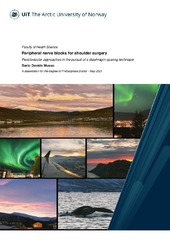| dc.contributor.advisor | Ytrebø, Lars Marius | |
| dc.contributor.author | Musso, Dario Davide | |
| dc.date.accessioned | 2021-08-12T14:12:29Z | |
| dc.date.available | 2021-08-12T14:12:29Z | |
| dc.date.issued | 2021-09-03 | |
| dc.description.abstract | <p>Background: Interscalene block is the gold standard for analgesia after shoulder surgery. However, it is associated with some block-related complications, especially the risk of hemidiaphragmatic paresis. In study I, we hypothesized that a more distal combination of nerve blocks would provide a feasible alternative to the gold standard. Study II was designed to optimize one of the components of the previous combination. In study III we wanted to put to the test the outcomes from the first two studies.
<p>Methods: In study I, 20 patients undergoing arthroscopic shoulder surgery received a combination of superficial cervical plexus block (SCPB), suprascapular nerve block (SSNB), and lateral sagittal infraclavicular block (LSIB). In study II, 23 patients received an LSIB targeting the posterior and lateral cords, to estimate minimum effective volume in 50% and 95% of the patients (MEV50 - MEV95). In study III, 20 adult patients undergoing shoulder arthroplasty received a combination of SSNB and LSIB of the posterior and lateral cords.
<p>Results: (I) 95% of patients underwent surgery with only light propofol sedation. (II) We estimated MEV50 = 7.8 ml and MEV95 = 9.0 ml. (III) surgery was performed under general anaesthesia with the above-mentioned nerve block combination. Median NRS (0-10) pain score 1, 3, 6, 8 and 24 hours postoperatively were 1, 0, 0, 0 and 3, respectively. During the first day, median NRS was 4, maximum NRS was 6.5. Total OMEq consumption was 52.5 mg. Incidence of hemidiaphragmatic paralysis was 5%.
<p>Conclusions: (I) The combination of SCPB, SSNB and LSIB provides surgical anaesthesia and satisfactory postoperative analgesia after arthroscopic shoulder surgery. (II) MEV50 = 7.8 ml, MEV95 = 9.0 ml for LSIB targeting posterior and lateral cord: with ropivacaine 7.5 mg/ml. (III) The combination of SSNB and LSIB shows encouraging postoperative analgesia profile and low risk for hemidiaphragmatic paralysis. | en_US |
| dc.description.doctoraltype | ph.d. | en_US |
| dc.description.popularabstract | Shoulder surgery can result in the highest pain score within orthopaedic surgery and, in absence of regional anaesthetic techniques, its postoperative pain intensity may require high consumption of opioids.
Interscalene brachial plexus block is currently the gold standard for intraoperative and postoperative pain management in patients undergoing this kind of surgery. In expert hands, it has a very high success rate, but it is associated with a wide spectrum of block-related complications, with the risk of hemidiaphragmatic paresis of prominent interest.
This thesis aims to study alternative techniques to the gold standard with special interest in the postoperative pain level, consumption of opioids and effect on the diaphragm. | en_US |
| dc.identifier.uri | https://hdl.handle.net/10037/22019 | |
| dc.language.iso | eng | en_US |
| dc.publisher | UiT The Arctic University of Norway | en_US |
| dc.publisher | UiT Norges arktiske universitet | en_US |
| dc.relation.haspart | <p>Paper I: Musso, D., Flohr-Madsen, S., Meknas, K., Wilsgaard, T., Ytrebø, L.M. & Klaastad, Ø. (2017). A novel combination of peripheral nerve blocks for arthroscopic shoulder surgery. <i>Acta Anaesthesiologica Scandinavica, 61</i>(9), 1192-1202. Also available at <a href=https://doi.org/10.1111/aas.12948>https://doi.org/10.1111/aas.12948</a>. Accepted manuscript version available in Munin at <a href=https://hdl.handle.net/10037/15279>https://hdl.handle.net/10037/15279</a>.
<p>Paper II: Musso, D., Klaastad, Ø., Wilsgaard, T. & Ytrebø, L.M. (2019). Brachial plexus block of the posterior and the lateral cord using ropivacaine 7.5 mg/mL. <i>Acta Anaesthesiologica Scandinavica, 63</i>(3), 389-395. Also available at <a href=https://doi.org/10.1111/aas.13277>https://doi.org/10.1111/aas.13277</a>.
<p>Paper III: Musso, D., Klaastad, Ø. & Ytrebø, L.M. (2021). A combination of infraclavicular and suprascapular never blocks for total shoulder arthroplasty: a case series. <i>Acta Anaesthesiologica Scandinavica, 65</i>(5), 674-680. Also available at <a href=https://doi.org/10.1111/aas.13787>https://doi.org/10.1111/aas.13787</a>. | en_US |
| dc.rights.accessRights | openAccess | en_US |
| dc.rights.holder | Copyright 2021 The Author(s) | |
| dc.rights.uri | https://creativecommons.org/licenses/by-nc-sa/4.0 | en_US |
| dc.rights | Attribution-NonCommercial-ShareAlike 4.0 International (CC BY-NC-SA 4.0) | en_US |
| dc.subject | VDP::Medisinske Fag: 700::Klinisk medisinske fag: 750::Anestesiologi: 765 | en_US |
| dc.subject | VDP::Medical disciplines: 700::Clinical medical disciplines: 750::Anesthesiology: 765 | en_US |
| dc.title | Peripheral nerve blocks for shoulder surgery - Periclavicular approaches in the pursuit of a diaphragm-sparing technique | en_US |
| dc.type | Doctoral thesis | en_US |
| dc.type | Doktorgradsavhandling | en_US |


 English
English norsk
norsk
